
Pistons are precision components, engineered within the nanometer to fit within a bore while maintaining enough clearance to account for thermal expansion and wear. Ordering the right replacement pistons starts with knowing which pistons you have -- especially crucial if you're looking at an engine that may already have experienced one or more rebuilds. Quantifying every single measurement on a piston would be a long and laborious project, but you need only a few crucial measurements to confidently specify replacements.
"Zero-out" your dial calipers by loosening the dial set-screw, closing the caliper jaws all the way and then rotating the dial face till it reads zero. Lock the set-screw in place to finish calibrating the gauge.
Slowly open the jaws of your dial calipers as far as they'll go, then close them on the sides of the piston slightly below the bottom of the wrist-pin bore. This is the "thrust surface" of the piston, where it tends to wear the quickest. Measuring here should give you the most accurate measurement, though the measurement isn't likely to be far off of that in other places.
Measure the inside of the pin bore with the inside-bore part of your dial calipers. Next, measure from the top edge of the cylindrical piston -- not the dome on top of the piston, if present -- to the top-inside of the pin bore. Add half the wrist pin bore diameter to get the piston's compression height. For example: Given a 0.50-inch pin bore and a 1.00-inch distance from the top of the bore to the top of the piston, the compression height would be 1.25 inches.
Clamp your caliper jaws on the outside of the piston and the inside of the pin bore on one side of the piston, then do the same on the other side. Measure the outside of the piston on both sides of the wrist pin and divide by two. Subtract from that half of the wrist pin bore diameter. This will give you the theoretical edge of the wrist pin bore if it were perfectly centered in the piston. Compare this theoretical measurement to the pin bore-to-piston side measurement you just took to determine whether the pin is offset to one side or the other.
Measure the vertical height of the piston from the bottom edge of the piston skirt -- the little tabs that hang down from the bottom of the piston -- to the top edge of the piston. Remember, dome height doesn't factor into this measurement. Measure skirt length from the bottom edge of the skirt to the top of the arches in between the skirts.
Slide the inside-bore side of your gauge into the bottom oil ring groove, the center compression ring groove and the top compression ring groove. Now, measure the "collars" or ridges in between the grooves using the top edge of the piston as a reference point. Measure from the top edge of the piston to the top of the first compression groove for the first collar, from the top edge of the top groove to the top edge of the second, and from the top edge of the second groove to the top edge of the third; this gives you the ring spacing.